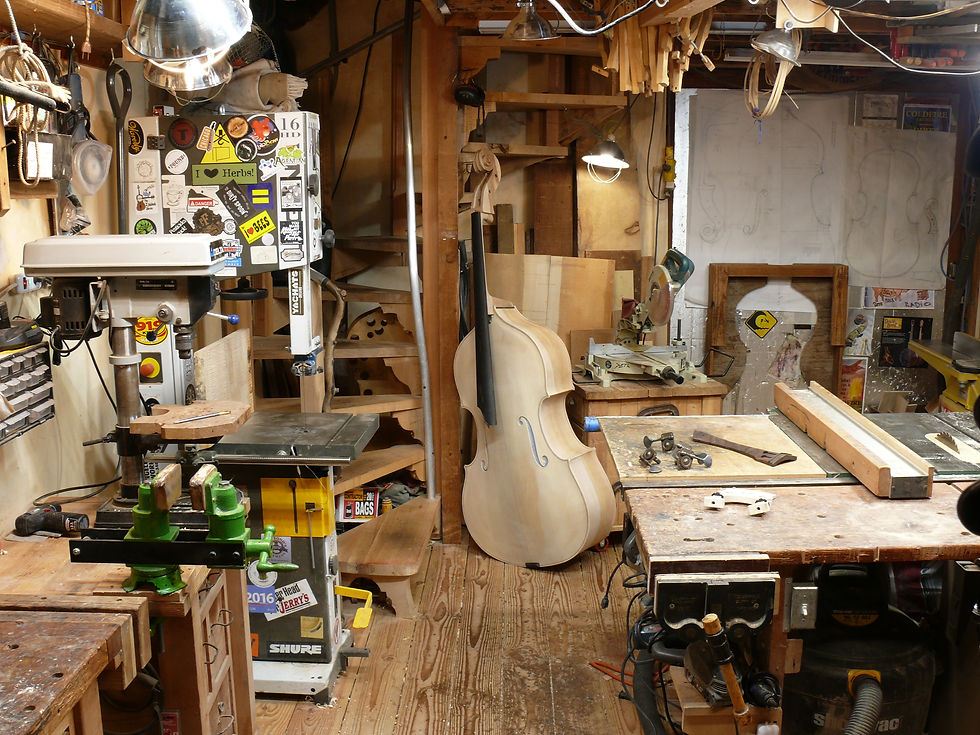
Key Shop
My Previous Commute--
photos of our new shop and property will be coming soon.

I built my work-shop in 1997, shortly after we bought our house in the East Skinner Butte Historic District of downtown Eugene, Oregon. That way we would have cover from which to work on the house! It is on the back of our small lot which featured a similar barn-like structure on it in the early 20th century. It is about 20 steps from our back door to the door of the shop.
The windows, upstairs flooring, and the painted trim, including the porch posts, are from a 1876 farmhouse, called The Key House, which we salvaged in conjunction with B.R.I.N.G. Recycling, from Camp Creek Road, in nearby Marcola, Oregon. Hence, I named it The Key Shop. The inspriation for the design, which I did myself, is a combination of that house --namely the porch and windows--and the historic photos of our lot which we obtained from the Lane County History Museum--namely the barn doors and overall shape and size. Both the shop and the addition to our house are sided with board and batten redwood which came from a local old-hippie and lumber supplier, Bill Conde, who used to be located just a few miles north of Eugene on I-5. We also used some of the windows from the Key house on the rehabilitation of our home, so they tie together nicely.























Click on slider images to stop and biggerize them.






















The shop is small. It is only 14'x18'. It's a floor and a half though, so it has a verticality that blends in with the historic "Eugene Vernacular" architecture of our neighborhood. A few years later, once we had finished restoring our home, I had the shop insulated with spray-in "Soysulation" (yup, spray-foam insulation made out of soy beans!). This helped keep it considerably warmer.
In the fall of 2015, I bit the bullet, took some time off from making basses, moved everything out and applied the finishing touches. I put in even more insulation, sheet-rocked, painted, fixed the stairs to make them safer and installed wooden car-decking on the floor downstairs. It was kind of a pain, but it was also kind of fun to use my contractor/carpenter skills again. And it was definitely worth it! I love working in the cleaner environment and the wood floor is much easier to stand on for hours than the concrete was. Not to mention it is even easier to heat, and I feel less bad about it when I need to run the dehumidifier.

Bass Manufacturing Facility
Sometimes people are confused when I say "shop" because in the music world that usually means having several basses or instruments or strings or something for sale in a showroom, but in the contracting world it just means work place. Atelier seems a bit fancy for me, hence, I have coined the somewhat tongue in cheek, but accurate term Bass Manufacturing Facility.
When I was a remodel contractor, the shop served as a cabinet shop and mill for many houses-worth of custom trim. I could open the street side barn-door and the porch door to run long pieces of lumber through my table saw. Making basses, which I started doing full time in 2009, thankfully feels much less crowded. I do still handle large, heavy billets of tone-wood, but they are usually only about 6 feet long, so and I only open the doors for the natural light and to catch the breeze as I work. I also still use all of my big machines: table saw, band saw, jointer, sliding compound mitre saw, lathe, belt and spindle sanders, drill press, and planer. Most of those big machines roll around on carts with lots of drawers that I built for them. The walls are covered with hammers and chisels and the like. I have many drawers and cupboards full of smaller tools, such as planes and knives and clamps as well. The ceiling joists are full of short wood. Upstairs I store patterns, hardware, and, maybe, even a bass and/or 'cello. The bonus is that it is also the perfect place to host band practices for my two American roots based music projects: Dirty Spoon and Butterchuck.








































Click on slider images to stop and biggerize them.

Click the video below to experience making a bass in under 2 minutes.
Big wood is key. And some of the tools I need are even larger than those mentioned, so for that I am thankful to have such wonderful local businesses to help me out.
Shout outs to:
Seth SanFilipo at Urban Lumber Company in Springfield, Oregon, for custom milling and supplying locally salvaged wood. We also get some gorgeous wood from Lewis and Sara Judy of Northwest Timber in Jefferson, Oregon, and from MVS (previously MountainVoice SoundWoods) in Valemont, British Colombia, Canada.
Thanks also to Larry at Nova Woodworks, located in wine country just outside of Eugene, Oregon, for sanding with his giant awesome sander which is as big as half my shop.
I always enjoy meeting and speaking with folks interested in all things double bass, so contact me to set up a time to come by for a tour!
If you have made it this far in and still want to see even more fun bits of the bass building process click here to check out "The Chip of the Day."